As an Amazon Associate, we earn from qualifying purchases with no additional costs for you.
People new to knife sharpening may not be aware of the terminology around knife sharpening and the nuances between the different processes. Sharpening and honing are two knife-sharpening terms that fall into this grey area of lack of understanding. We will give you a simple explanation of each process and the differences between the two.
Sharpening a knife is the process of restoring a dull knife edge to a sharp edge capable of cutting. Honing a knife edge is the process of re-establishing the keenness of the edge on a knife that is already sharp. Sharpening a knife makes it sharp; honing a knife makes it razor-sharp.
Sharpening a knife and honing a knife, in some instances, may look very similar, but the methods achieve different outcomes on the edge of the knife and the resulting cutting ability of the edge. Knowing what each process does and the order in which these processes are performed is a foundation principle of knife sharpening methodology.
If you are interested in checking out the best honing steels or whetstones for honing or sharpening knives, we recommend you can find them by clicking here and here (Amazon links).
Do You Sharpen Or Hone A Knife First?

This is a good question for beginner knife sharpeners, and it is much like the question about which came first: the chicken or the egg?
On a knife that has no edge, sharpening is the process that comes first, and honing is the final process that finishes the sharp edge. The edge must be evaluated on a knife that already has an edge to establish if it needs sharpening or honing.
If we go back to the beginning of a knife’s life, once the knife maker has completed the knife build, it is time to put an edge on the blade.
At this juncture in a knife’s life, it has no sharp edge and is unable to cut. The process applied to establish the cutting edge on the knife for the first time is sharpening.
Once an edge is on the knife, subsequent processes performed on the edge may vary. In some instances, honing may be the first process chosen to return the knife to sharp, and in other instances, sharpening would be the process of choice to recondition the edge.
The question regarding when you use each process on a knife’s edge will become clear as we delve into the two processes and their effect on the knife’s edge.
TIP: If you want to know more about what comes first, honing or sharpening, check out the ultimate answer in the article below:
Sharpen Or Hone A Knife: What Comes First?
Is Honing A Knife The Same As Sharpening?
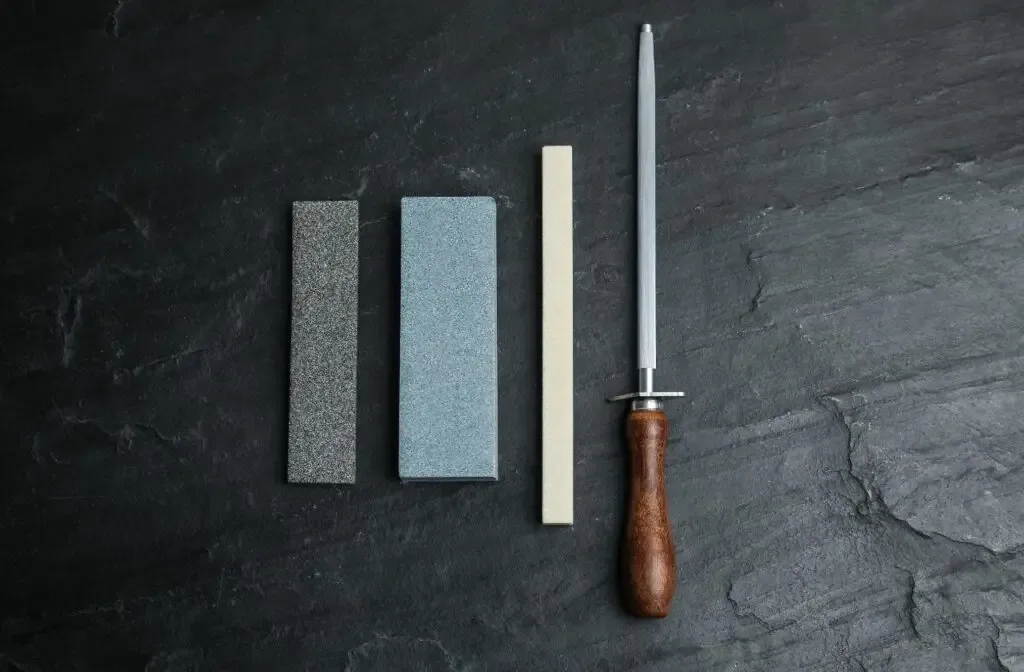
As you may have picked up from our discussion thus far, honing and sharpening are two processes involved in making a knife sharp.
Even though the two methods work in tandem to get a sharp edge on a knife, there are differences in the processes: what they do to the knife’s edge and when they are used on a knife.
To shed further light on the processes, we have included a short description of honing and sharpening, which should clarify each to the newbie knife sharpener and bring a basic understanding of what each process accomplishes.
What Is Honing A Knife? Short Explanation
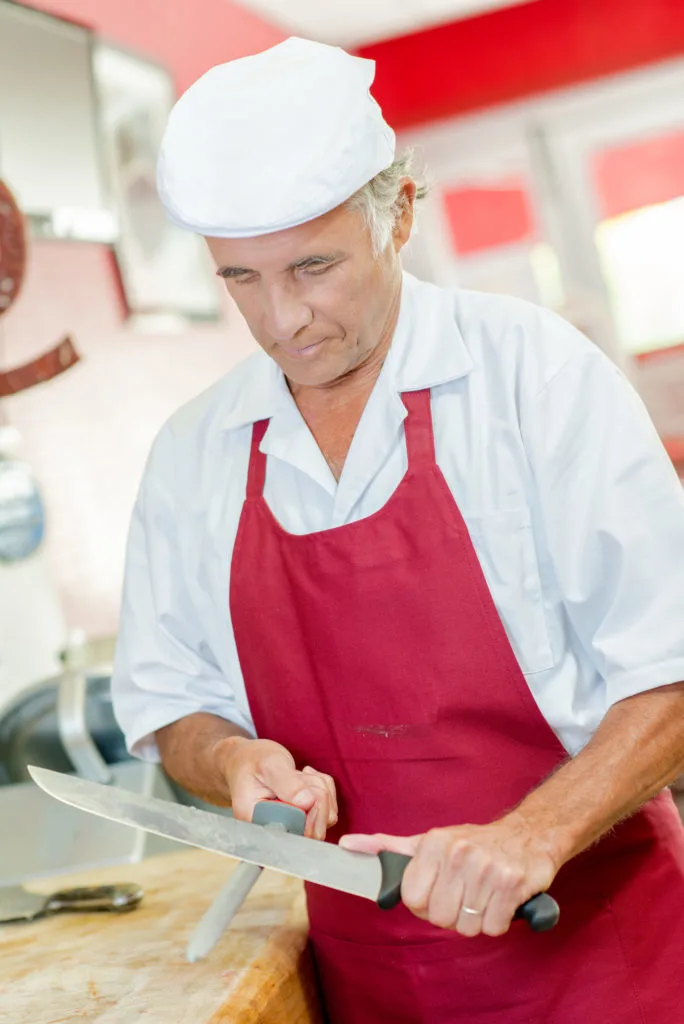
Honing a knife is a process that is undertaken on a knife that already has a cutting edge. Honing cannot be used to repair a damaged knife edge or to put an edge on a knife for the first time. The secondary bevels on a knife’s cutting edge must already be established before honing can take place.
When a knife has a sharp edge, using the knife may result in the knife losing the keenness of the edge. The knife is still sharp, but it does not cut quite as well as it used to.
This is often due to the thin metal on the edge of the cutting edge rolling over slightly or becoming wavy. Honing remedies this situation and straightens the edge to restore cutting efficiency.
Honing a knife’s edge essentially serves two purposes when performed on the knife. It straightens out the fine, cutting edge of the knife, and it polishes and refines the edge.
This restores the cutting edge to razor sharpness, reducing friction in the cut as the edge passes through the item being cut.
Honing a knife is a less aggressive process on the knife’s edge and does not remove much metal from the cutting edge.
What Tools Do You Use To Hone A Knife?
There are a variety of tools you can use to hone a knife. The choice of tool to use will often be dictated by the type of knife you are honing.
Honing tools can include the following.
- Honing steel. This is normally a rod-shaped device that can be made from steel, ceramic, or diamond abrasive. The intention of the honing steel is to straighten the edge and give it a polish. Honing steels are inappropriate for use on some knives, especially Japanese kitchen knives.
- A leather strop. A leather strop combined with fine abrasive compounds makes an excellent honing device that can be used on any knife.
- Honing stones. Very high-grit honing stones, usually above 6000-grit, be they whetstones, diamond stones, ceramic, or glass stones, can be used to hone a knife’s edge.
Our choice: If you are interested in buying the best honing rod for honing knives, we recommend buying the Green Elephant Ceramic Sharpening Rod (Amazon Link)
Honing steels are most commonly used on Western-style kitchen knives and knives that generally have thinner blades. Hones should not be used on Japanese kitchen knives, which are made of hard, brittle steel. A hone used on these knives can chip and crack the cutting edge.
A strop is a versatile, quick method of honing that can be used on pretty much any knife, whether thick steel, thin steel, soft steel, or hard steel.
Honing stones provide the most control over the honing process, but using whetstones of various types is a skill you will need to develop. However, once the skill is learned, this is one of the best methods to hone a knife.
TIP: Japanese knives belong to the most popular knives around the world, but caring for them is a bit different than for other knives. Can you hone Janapese knives? Check out the explanation in the article below:
Should You Hone Your Japanese Knives? You Should Know This
What Is Knife Sharpening? Short Explanation
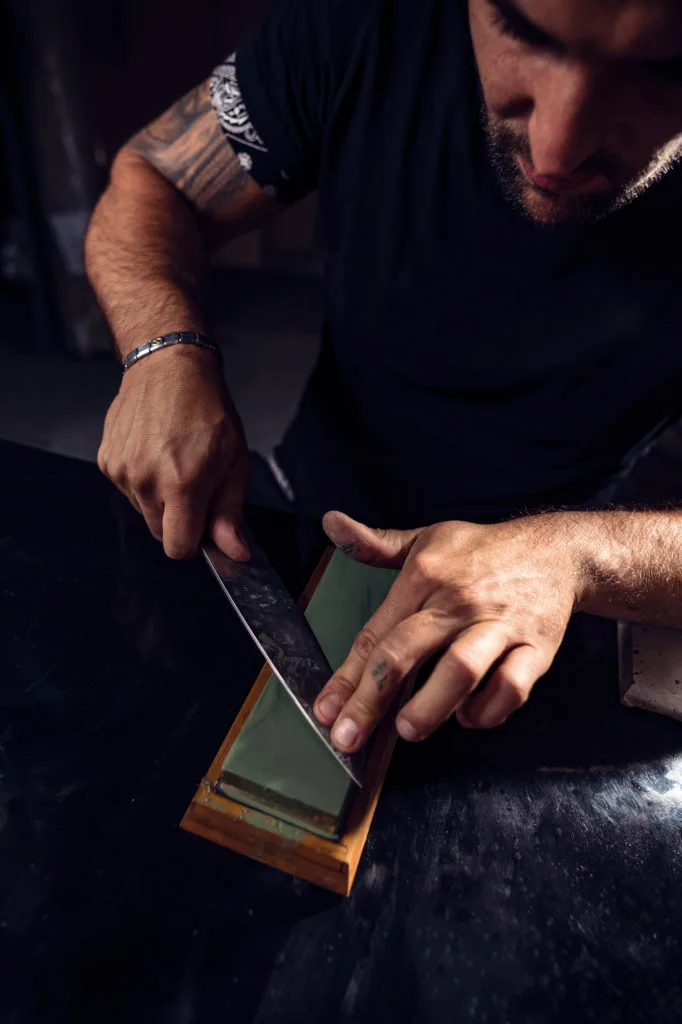
Sharpening a knife is a substantially more aggressive process than honing a knife, removing a significant amount of metal from the edge.
Sharpening is used to establish the initial edge on the knife, repair the edge of a knife, and refurbish the edge of a knife.
The initial knife sharpening is used to grind in the secondary bevels on the cutting edge at angles appropriate to the blade and purpose of the knife. The process begins with very coarse abrasives to rough in the basic shape and angles of the cutting edge.
The process continues, moving through consecutively finer grits of abrasives to fine-tune the cutting edge, making the edge capable of cutting.
Once a knife is sharp and used for its intended purpose, the edge will suffer wear and tear and become dull or even damaged.
Sharpening can be used to repair a damaged cutting edge on a knife and bring the edge back to sharp. The intensity of the sharpening process and the aggressiveness of the abrasives used in this sharpening process will be determined by the state of the knife’s edge.
If the edge only requires a touch-up, less aggressive abrasives will be used to refurbish the edge, removing less metal from the blade in the process
What Tools Do You Use To Sharpen A Knife?
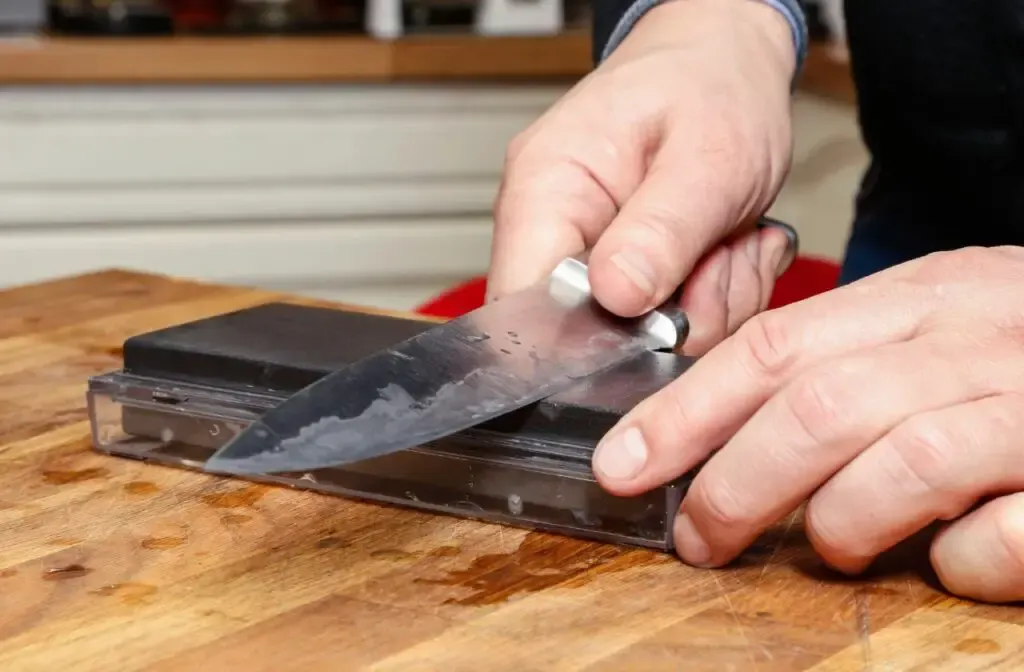
There are a variety of tools available for sharpening knives, with some better than others and some only suitable for certain types of knives only.
Here is a list of sharpening tools and ideas regarding their useability.
- Pull-through sharpeners. Very basic sharpening ability used to touch up edges rather than extensive sharpening. Sharpening angles are fixed, making them suitable for certain knives only.
- Electric sharpeners. These are slightly better than most pull-through sharpeners but are still fairly limited in their sharpening ability. More angles are available, but usually a set number of more common sharpening angles.
- Whetstones. Whetstones are a broad category that includes water, oil, diamond, ceramic, and glass stones. These tools are the most versatile, being able to sharpen knives and repair knife edges and using the full range of sharpening angles. Skill and practice are required to effectively sharpen knives with these tools.
- Sharpening systems. There is a large variety of sharpening systems available that use the types of abrasives common to whetstones. The system, however, reduces the difficulty and skill level typically required to sharpen knives with whetstones. These systems are very useful for beginners, but some can be quite expensive.
The best way to start knife sharpening as a beginner and get professional results is by using a sharpening system.
However, the most versatile sharpening method for sharpening is with whetstones. It may take time to learn the skills to sharpen knives effectively with whetstones, but it is worth the effort.
TIP: Are you looking to buy a new whetstone? Check out our recommendations (we personally use the first three ones):
Our PRO choice whetstones combo (Amazon links):
- Fixing stone: Whetstone SHAPTON Ceramic KUROMAKU #320
- Sharpening stone: Suehiro CERAX soaking whetstone: Medium #1000
- Finishing stone: Whetstone SHAPTON Ceramic KUROMAKU #5000
Our budget choice (Amazon link): Sharp Pebble Extra Large Sharpening Stone Set
What Is The Difference Between Honing And Sharpening?
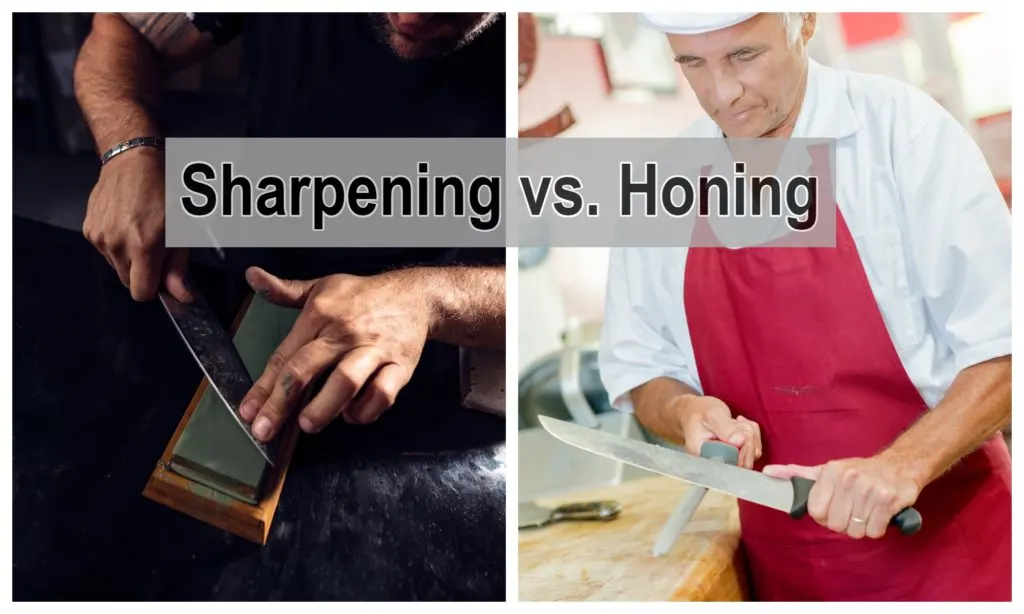
We have covered the two processes involved in putting a sharp edge on a knife: sharpening and honing. Both processes are required to achieve an effective edge on the knife.
So, what are the main differences between the two processes that set them apart from each other? The best way to depict the differences between honing and sharpening is to present them side-by-side in a table.
| Honing | Sharpening | |
|---|---|---|
| Purpose | Restore keenness to an already sharp edge and polish the edge to reduce friction | Sharpening is much more aggressive, removing considerable amounts of steel from the knife’s edge. |
| Aggressiveness | Honing straightens the fine edge and removes small quantities of steel to refine and polish the edge. The honing process is not aggressive. | Honing can be done frequently to keep the edge maintained and reduce the necessity of frequent sharpening. Honing removes little to no material from the knife while improving cutting efficiency. |
| Frequency | Sharpening is a more time-consuming process that can take anywhere from 5 minutes to 45-minutes, depending on the state of the knife. | Sharpening should be done less frequently because it is a more aggressive process that removes a lot of steel from the knife’s edge. Frequent sharpening will reduce the longevity of the knife. |
| Time | Honing takes very little time, in some cases, only seconds. | Sharpening is a more time-consuming process that can take anywhere from 5 minutes to 45 minutes, depending on the state of the knife. |
TIP: One of the most common questions when sharpening a knife is: pull or push a knife? Check out what the correct way is in the article below:
Push Or Pull When Sharpening A Knife? Correct Way Explained
What Is The Difference Between A Honing Steel And A Sharpening Steel
There are some discrepancies in the naming of a honing steel and a sharpening steel. Sometimes, honing steels are marketed as sharpening steels because the perception is they make your knife.
There are also sharpening steels that act as honing steels but have a light grit abrasive included, such as a diamond sharpening steel, which will remove more material than a typical honing rod. They are called sharpening rods to differentiate them from standard honing rods.
A sharpening rod does not sharpen your knife in the same sense of the word and a proper sharpening process. A sharpening rod will hone the knife and possibly polish the cutting edge to improve the cutting performance.
The purpose of honing steels is to re-align the knife’s edge, not remove material, as is typically done in a sharpening process.
The naming of these tools as “steels” is a throwback to the days when they were made from steel. Modern honing steels can be made from steel, ceramic, or diamond-coated steel.
The diamond-coated steels are commonly called sharpening steels to distinguish them from those that are not abrasive.
A sharpening steel is essentially a slightly more aggressive honing steel.
TIP: Sharpening serrated knives is more complicated than other knives. That’s why you need to use a bit different sharpeners for serrated knives. Check out the best ones in the article below:
TOP 7 Knife Sharpeners For Serrated Knives: Complete Guide
Should I Hone My Knife After Sharpening?
Honing a knife is an integral part of knife sharpening and should always be the final step in the process to finalize the cutting edge.
Sharpening a knife develops a burr along the blade’s edge as material is removed from the cutting bevels.
The burr is a thin, jagged piece of waste steel left behind on the cutting edge after the sharpening. This burr must be removed to finish the sharpening process and refine the edge.
The honing process using a high-grit whetstone or a strop with a honing compound is ideal for removing the burr, polishing the edge, and taking it to its final sharpness.
Safety Tips For Sharpening and Honing a Knife
Ensuring safety while maintaining your knives is paramount. Regardless of your skill and experience using and sharpening knives, understanding the safety protocols for sharpening and honing knives is crucial.
Let’s identify specific safety tips for using a whetstone, pull-through knife sharpener, and a honing rod. A safe sharpening experience not only protects you but also ensures the longevity and efficacy of your knives.
When sharpening a knife with a whetstone, ensure your whetstone is stable and secure to prevent it from slipping. Using a non-slip mat or a holder can provide additional stability.
Maintain a consistent angle between the knife and the stone to prevent accidental slips or cuts. Always keep your eyes on the blade and the stone, ensuring you are fully attentive to the sharpening process.
Consider using cut-resistant gloves to protect your hands during the sharpening process, and always store the whetstone securely and in a dry place to prevent accidental slips or falls.
When using a pull-through knife sharpener, place the sharpener on a flat, stable surface to prevent any wobbling or shifting during use. Ensure your hands are dry and firmly grip the handle of the sharpener to avoid slips.
Pull the knife through the sharpener with a steady, controlled motion to prevent any jerky movements or accidents. Always ensure the blade is facing away from you, and keep fingers clear of the sharpening slot.
It is always important to adhere to the manufacturer’s guidelines regarding the number of pulls and pressure to be applied when using a sharpener like this.
When using a honing rod on any knife, hold the honing rod firmly and, if possible, place its tip on a stable surface or use a guard to ensure it doesn’t move during honing.
Maintain a consistent angle between the knife and the rod to ensure effective honing and prevent slipping. Use smooth and controlled strokes when sliding the knife along the rod. Ensure there is ample space around you to prevent any accidental injuries to bystanders.
It is critical to inspect your honing rod regularly for any wear or damage to ensure it functions safely and effectively.
Sharpening and honing are integral to maintaining your knives, but ensuring you do so safely is equally vital. Always prioritize your safety and those around you by adhering to these tips and guidelines.
A well-maintained knife is a safe knife, and a safe sharpening practice ensures that your culinary journey remains a joyous and injury-free experience.
Conclusion
Sharpening and honing are two sides of the same knife-sharpening coin. Honing a knife is a process that can be performed frequently to keep the edge working well and limit the need to sharpen the knife frequently.
Sharpening is used to establish an edge on a knife, fix damaged edges, and sharpen dull knives, but it should always be followed by honing to finalize the edge.
Together, these two processes will give you the edge on your knives that will make them perform as they should for their intended tasks!
TIP: Whetstones are the best tools for knife sharpening. A lot of people are interested if you need to lubricate the whetstone before sharpening. Find out more about this interesting topic in the article below:
Lubricating A Sharpening Stone: The 12 Do’s & Don’ts

